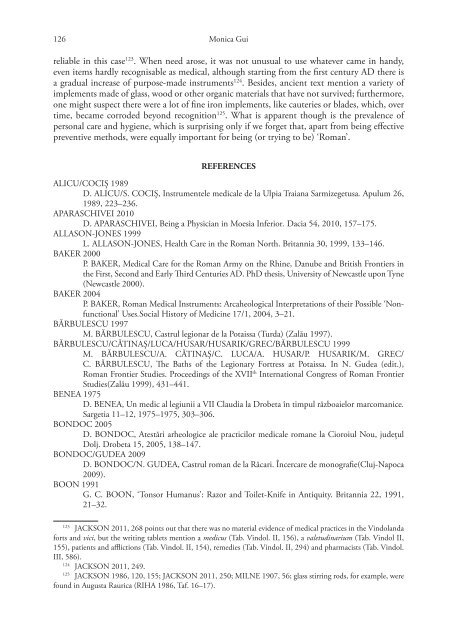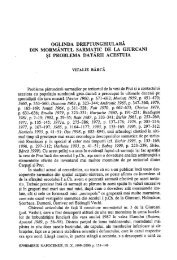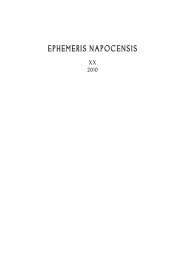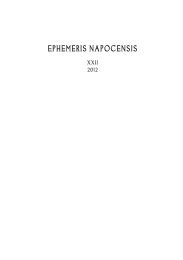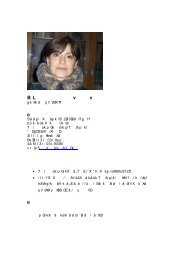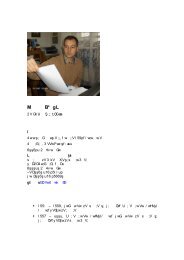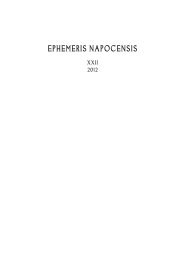ephemeris napocensis 2011 cu corectura.indd - Institutul de ...
ephemeris napocensis 2011 cu corectura.indd - Institutul de ...
ephemeris napocensis 2011 cu corectura.indd - Institutul de ...
Create successful ePaper yourself
Turn your PDF publications into a flip-book with our unique Google optimized e-Paper software.
126 Monica Guireliable in this case 123 . When need arose, it was not unusual to use whatever came in handy,even items hardly recognisable as medical, although starting from the first century AD there isa gradual increase of purpose-ma<strong>de</strong> instruments 124 . Besi<strong>de</strong>s, ancient text mention a variety ofimplements ma<strong>de</strong> of glass, wood or other organic materials that have not survived; furthermore,one might suspect there were a lot of fine iron implements, like cauteries or bla<strong>de</strong>s, which, overtime, became corro<strong>de</strong>d beyond recognition 125 . What is apparent though is the prevalence ofpersonal care and hygiene, which is surprising only if we forget that, apart from being effectivepreventive methods, were equally important for being (or trying to be) ‘Roman’.REFERENCESALICU/COCIȘ 1989D. ALICU/S. COCIȘ, Instrumentele medicale <strong>de</strong> la Ulpia Traiana Sarmizegetusa. Apulum 26,1989, 223–236.APARASCHIVEI 2010D. APARASCHIVEI, Being a Physician in Moesia Inferior. Dacia 54, 2010, 157–175.ALLASON-JONES 1999L. ALLASON-JONES, Health Care in the Roman North. Britannia 30, 1999, 133–146.BAKER 2000P. BAKER, Medical Care for the Roman Army on the Rhine, Danube and British Frontiers inthe First, Second and Early Third Centuries AD. PhD thesis, University of Newcastle upon Tyne(Newcastle 2000).BAKER 2004P. BAKER, Roman Medical Instruments: Arcaheological Interpretations of their Possible ‘Nonfunctional’Uses.Social History of Medicine 17/1, 2004, 3–21.BĂRBULESCU 1997M. BĂRBULESCU, Castrul legionar <strong>de</strong> la Potaissa (Turda) (Zalău 1997).BĂRBULESCU/CĂTINAȘ/LUCA/HUSAR/HUSARIK/GREC/BĂRBULESCU 1999M. BĂRBULESCU/A. CĂTINAȘ/C. LUCA/A. HUSAR/P. HUSARIK/M. GREC/C. BĂRBULESCU, The Baths of the Legionary Fortress at Potaissa. In N. Gu<strong>de</strong>a (edit.),Roman Frontier Studies. Proceedings of the XVII th International Congress of Roman FrontierStudies(Zalău 1999), 431–441.BENEA 1975D. BENEA, Un medic al legiunii a VII Claudia la Drobeta în timpul războaielor marcomanice.Sargetia 11–12, 1975–1975, 303–306.BONDOC 2005D. BONDOC, Atestări arheologice ale practicilor medicale romane la Cioroiul Nou, ju<strong>de</strong>țulDolj. Drobeta 15, 2005, 138–147.BONDOC/GUDEA 2009D. BONDOC/N. GUDEA, Castrul roman <strong>de</strong> la Răcari. Încercare <strong>de</strong> monografie(Cluj-Napoca2009).BOON 1991G. C. BOON, ‘Tonsor Humanus’: Razor and Toilet-Knife in Antiquity. Britannia 22, 1991,21–32.123JACKSON <strong>2011</strong>, 268 points out that there was no material evi<strong>de</strong>nce of medical practices in the Vindolandaforts and vici, but the writing tablets mention a medi<strong>cu</strong>s (Tab. Vindol. II, 156), a valetudinarium (Tab. Vindol II,155), patients and afflictions (Tab. Vindol. II, 154), remedies (Tab. Vindol. II, 294) and pharmacists (Tab. Vindol.III, 586).124JACKSON <strong>2011</strong>, 249.125JACKSON 1986, 120, 155; JACKSON <strong>2011</strong>, 250; MILNE 1907, 56; glass stirring rods, for example, werefound in Augusta Raurica (RIHA 1986, Taf. 16–17).


